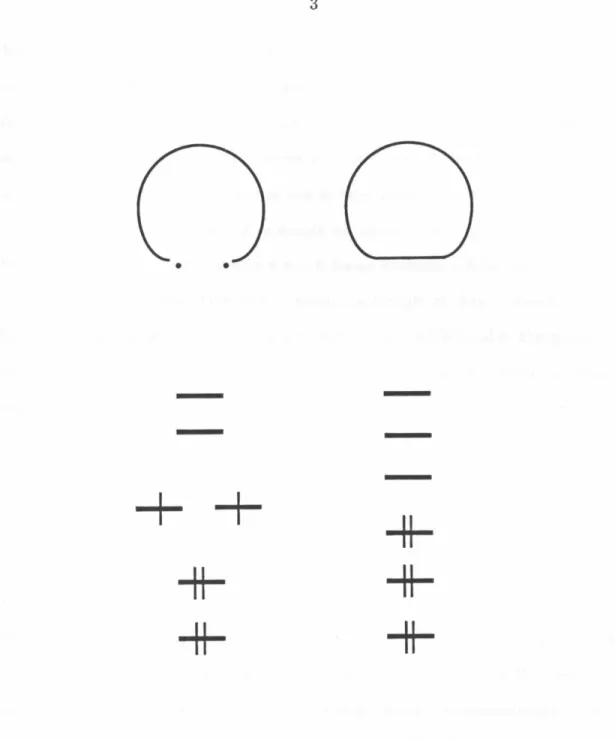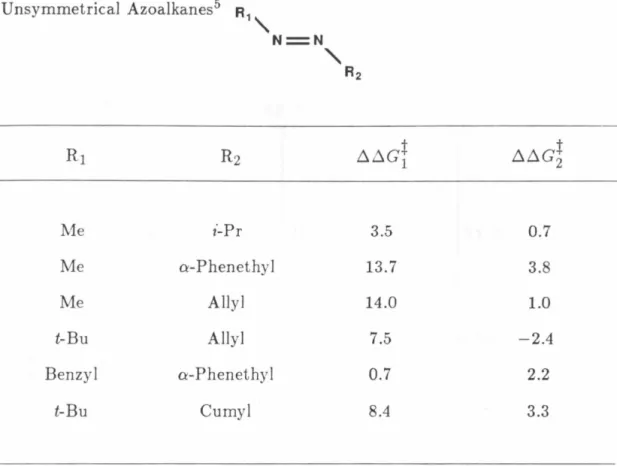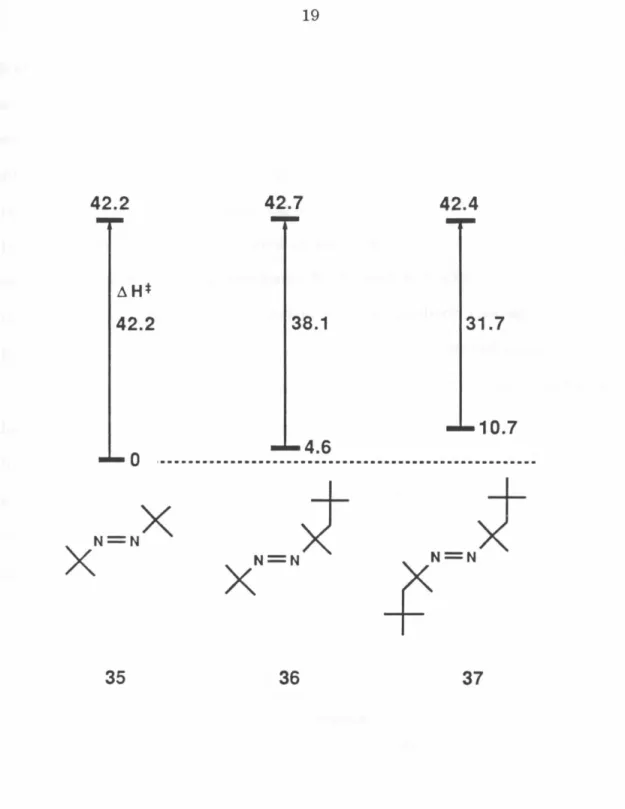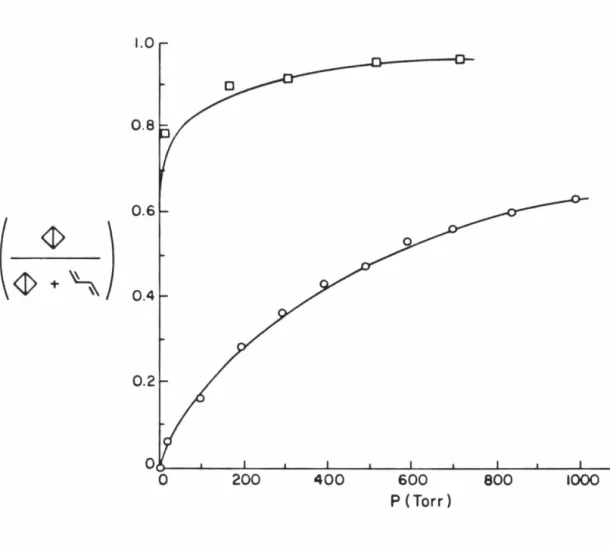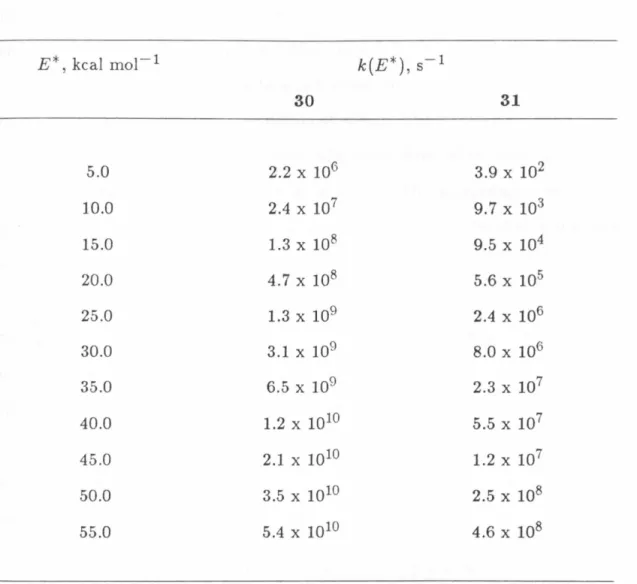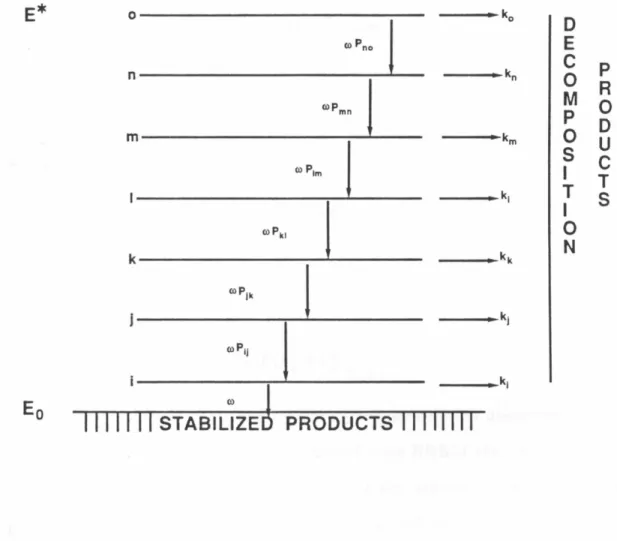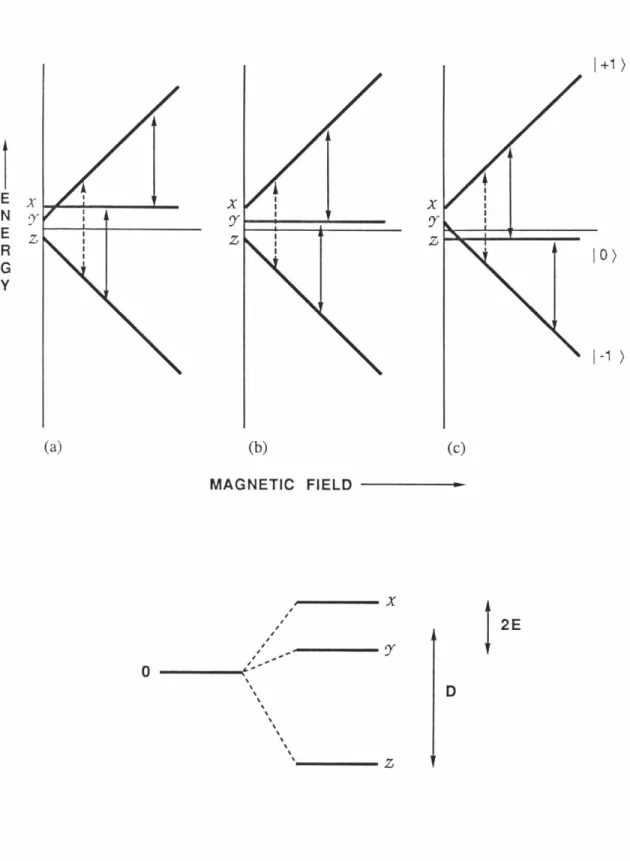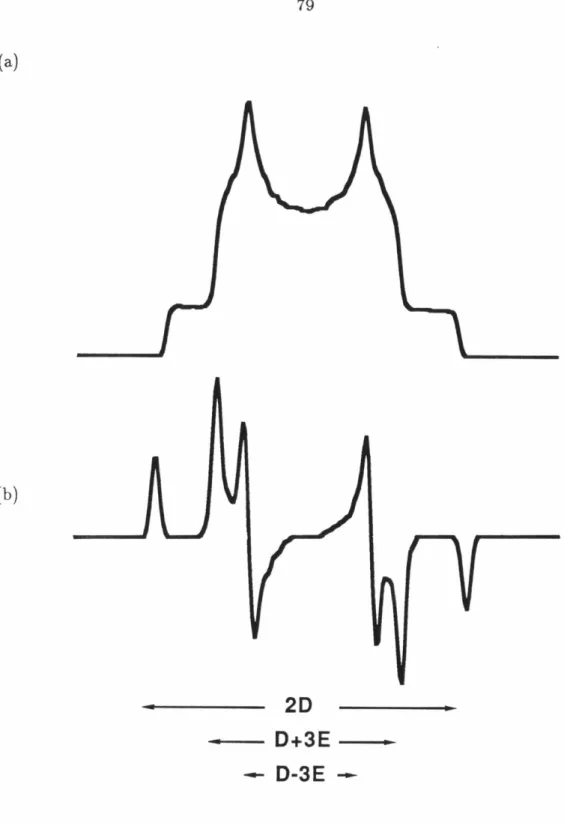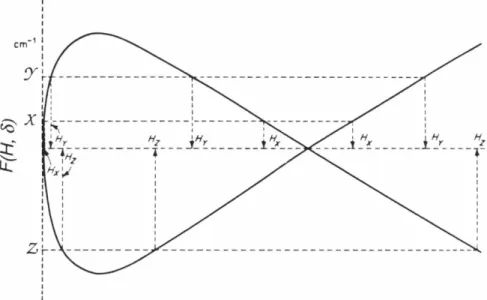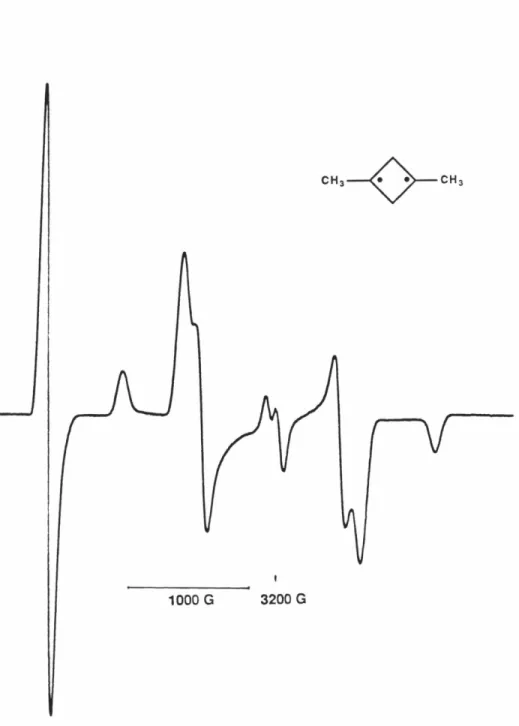ORGANIC BIRADICALS
GENERATED FROM NOVEL BICYCLIC AZOALKANES
Thesis by RAKESH JAIN
In Partial Fulfillment of the Requirements for the Degree of
Doctor of Philosophy
California Institute of Technology Pasadena, California
1987
(Submitted October 3, 1986)
TO MY FAMILY
ACKNOWLEDGEMENTS
It was a pleasure to work for my advisor Dennis Dougherty, and I extend my sincerest thanks for his scientific guidance, encouragement and friendship during my stay at Caltech. Being a member of the Dougherty group was a wonderful experience, and everyone in the group was extremely helpful. Spe- cial thanks go to Gary Snyder and Lisa McElwee- White, without whom ESR studies would have been a lot tougher. Mike Sponsler, Mike Petti and Tim Shepodd, with whom I shared my first laboratory at Caltech, will always be remembered with especially fond memories. Of course, all my other colleagues in the Dougherty, Dervan and Grubbs groups will never be forgotten either.
Tom Dunn in the electronic shop was a great help. Without his exper- tise and willingness to fix almost anything, I would have been left in the lurch on innumerable occasions.
I also gratefully acknowledge Dave Stauffer's help in proofreading this thesis.
ABSTRACT
Thermolysis of 2,3-diazabicyclo(2.1.1 )hex-2-ene (14) in the gas phase produces highly vibrationally excited (chemically activated) bicyclo(l.l.O)butane (30). The excited 30 rearranges to butadiene, in competition with collisional deactivation by a bath gas. Quantitative modeling using RRKM theory and a stepladder model for collisional deactivation indicates that of the substantial amount of excess energy available to the products of thermolysis of 14, the great majority lies in the hydrocarbon fragment (30). Within the framework of a mechanistic criterion developed previously by Bauer, this result suggests that 14 decomposes by a stepwise, one-bond cleavage involving an intermedi- ate diazenyl biradical. We have also synthesized 16, the dimethyl derivative of 14, and studied its thermal decomposition. As predicted by RRKM cal- culations, gas phase thermolysis of 16 does not produce chemically activated 1,3-dimethylbicyclobutane (31).
Irradiation of frozen solutions of 1,4-dialkyl-2,3-diazabicyclo[2.1.1 )hex- 2-enes (16-19) in the cavity of an ESR spectrometer between 4 and 25 K pro- duces the corresponding triplet 1,3-dialkyl-1,3-cyclobutanediyls (20- 23). The spectra display zero-field splitting parameters,
I D I
hci = 0.112 em - 1 andIE I
hci=
0.005 em - 1. Hyperfine coupling can be resolved in some of these spectra and can be simulated using a computer program which has been developed for the purpose. The decay of the ESR signals between 4 and 25 K is nonexponen- tial and shows very little dependence on temperature. A novel approach for analyzing the matrix-site effect is used and evidence is provided for quantum- mechanical tunneling in the decay process.Matrix isolation photolysis of 2,3-diazabicyclo[2.2.1 )hept-2-ene-7 -spiro-
cyclopropane (24) and 2,3-diazabicyclo[2.2.1]hept-2-ene-7 ,51 -spirobicyclo[2.1.0]- pentane (25) between 4 and 35 K produces triplet ESR signals which are thermally stable up to 150 K. Independent generation from direct precursors 7-ethy lidene-2,3-diazabicyclo[2.2.1]hept-2-ene (71) and 7-cyclobutylidene-2,3- diazabicyclo[2.2.1]hept-2-ene (72) confirms the assignment of the ESR signals to triplet biradicals 2-ethylidene-1,3-cyclopentanediyl (28) and 2-cyclobutyl- idene-1,3-cyclopentanediyl (29), respectively. Interpretable hyperfine coupling is observed and can be simulated, providing direct information about the elec- tronic structures of these biradicals. The mechanism proposed for the forma- tion of 28 and 29 from 24 and 25 involves two biradical rearrangements; a cyclopropylcarbinyl-type ring opening followed by a 1,2-H shift. Neither of these rearrangements can occur via thermal activation at such low tempera- tures. Chemical activation and quantum-mechanical tunneling are proposed to explain the reactivity of the intermediary biradicals.
TABLE OF CONTENTS
Acknowledgements Abstract
List of Figures List of Tables Chapter I
Chapter II
Appendix A Chapter III
INTRODUCTION References
ONE-BOND CLEAVAGE IN A SYMMETRICAL BICYCLIC AZOALKANE
Synthesis
Solution Phase Thermal Chemistry Gas Phase Thermal Chemistry
Thermochemistry and RRKM Calculations Mechanistic Implications
Experimental Section References
RESULTS OF RRKM CALCULATIONS 1,3-DIALKYL-1,3-CYCLOBUTANEDIYLS Synthesis
Electron Spin Resonance Studies The Spin Hamiltonian
Simulation of Triplet ESR Spectra Results
Hyperfine Coupling
Page
lli
IV
viii
Xll
1 13
15 23 26 27 32 44 47 52 56 69 73 77 80 87 89 94
Decay Kinetics Reaction Pathway Experimental Section References
101 129 134 143 Appendix B SOURCE LISTING OF COMPUTER PROGRAMS 147 Chapter IV BIRADICAL REARRANGEMENTS AT 4 K 160
Results
Hyperfine Coupling Discussion
The Stepwise Mechanism Alternative Mechanisms Magnitude of hfc Constants Experimental Section References
Appendix C RESULTS OF RRKM CALCULATIONS
161 168 180 184 191 192 197 203 208
LIST OF FIGURES
Page Figure 1 Molecular Orbital picture of an organic biradical and
its closed-shell form 3
Figure 2 Relative 11Hj of ground state azoalkanes 35, 36, and 37,
and the transition states for their deazetation 19 Figure 3 Product Composition from gas phase thermolysis of 14
as a function of pressure 30
Figure 4 Energetics for the thermal decomposition of 10 and 14 33 Figure 5 Energy region and microscopic kinetic processes for the
deactivation scheme 40
Figure 6 Theoretical fits to product composition data from gas
phase thermolysis of 14 43
Figure 7 Triplet energy levels as a function of magnetic field
strength 78
Figure 8 Theoretical absorption and derivative spectra for a
randomly oriented triplet system 79
Figure 9 The value of the function F(H, 6) for a particular
orientation plotted against magnetic field strength 86 Figure 10 ESR spectrum for 20 obtained upon photolysis of an
MTHF matrix containing 16 at 4 K 90
Figure 11 ESR spectrum for 22 obtained upon photolysis of an
MTHF matrix containing 18 at 4 K 91
Figure 12 ESR spectrum for 23 obtained upon photolysis of an
MTHF matrix containing 19 at 4 K 92
Figure 13 The l::im8 = 2 region of the ESR spectrum for 21 96
Figure 14 The ~ms
=
2 regions of the ESR spectra for 65, 66, and 3 97 Figure 15 Simulated ~ms=
2 regions of the ESR spectra for21 and 65 100
Figure 16 Intensity of the ESR signal vs. time plots for the generation and decay of 20 in MTHF at various temperatures 104 Figure 17 Intensity of the ESR signal vs. time plots for the generation
and decay of 20 in acetone at various temperatures 105 Figure 18 Intensity of the ESR signal vs. time plots for the generation
and decay of 2 2 in MTHF at various temperatures 106 Figure 19 Intensity of the ESR signa] vs. time plots for the generation
and decay of 22 in acetone at various temperatures 107 Figure 20 Examples of erratic behavior of intensity of the ESR signal
for biradicals 20 and 22 in MTHF 109
Figure 21 Intensity of the ESR signal vs. time plots for the generation and decay of 11 in MTHF at various temperatures 111 Figure 22 Intensity of the ESR signal vs. time plots for the generation
and decay of 11 in cyclohexane at various temperatures 112 Figure 23 Fits to the decay data for 11 in MTHF at various
temperatures 117
Figure 24 Fits to the decay data for 11 in cyclohexane at various
temperatures 118
Figure 25 Fits to the decay data for 20 in acetone at various
temperatures 119
Figure 26 Fits to the decay data for 22 in acetone at various
temperatures 120
Figure 27 Theoretical decay curves calculated assuming
Figure 28
Figure 29
Figure 30 Figure 31
Figure 32
Figure 33
Figure 34
Figure 35
Figure 36
Figure 37
Figure 38
Figure 39
Figure 40
Arrhenius behavior
Arrhenius plots of the most probable rate constants for 11, 20, and 22
Calculated rates including tunneling component for 11 along with experimental data
General energy diagram for the reactivity of biradicals Intensity vs. time plots for the decay of 20 in
acetone and in acetone-d5 at 4 K
ESR spectrum obtained upon irradiation of an MTHF matrix containing (a) 24 and (b) 71
ESR spectrum obtained upon irradiation of an MTHF matrix containing (a) 25 and (b) 72
Half-field ( ~ ms
=
2) transitions in the ESR spectra obtained from (a) 24, (b) 71, and (c) 78Half-field (~ms
=
2) transitions in the ESR spectra obtained from (a) 25, (b) 72, (c) 74, and (d) 75Absorption ESR spectra obtained by integrating the half-field
(~ms = 2) transition in the spectrum generated by photolysis of (a) 25 or 72, (b) 74, and (c) 75
122
123
127 130
132
162
163
169
170
172 Simulated half-field (~ms
=
2) transitions for the ESR spectra obtained from (a) 25 or 72, (b) 74 , and (c) 75 173 Simulated half-field (~ms = 2) transitions for the ESR spectra obtained from 78ESR spectrum obtained upon irradiation of an MTHF matrix containing 88
Thermochemistry for the decomposition of 24
175
179 182
Figure 41 Dependence of signal intensity on light intensity 193
Table I
Table II Table III
Table IV
Table V
Table VI Table VII
Table VIII
Table IX Table X
Table XI
LIST OF TABLES
Differences in Free Energy of Activation between Symmetrical and Unsymmetrical Azoalkanes Rates for Thermolysis of 16 in Benzene
Activation Parameters for Thermolysis of Bicyclic Azoalkanes
Unimolecular Rate Constants for 30 and 31 from RRKM Calculations
Product Yields from Photolysis of 16 at Room Temperature
ZFS Parameters for Selected Biradicals
Positions of Turning Points for ESR Spectra for Triplet Biradicals in the !::l.m8 = 2 Region
Characteristic Parameters of the Distributions Giving the Best Fits to Decay Data
ZFS Parameters for Various Biradicals
Composition of the Product Mixture Obtained upon Photolysis of 24 at Various Temperatures
Unimolecular Rate Constants for 26 from RRKM Calculations
Page
18 28
29
38
74 93
98
121 164
183
188
CHAPTER I
INTRODUCTION
The study of organic biradicals 1 has been at the forefront of research in physical organic chemistry in recent years. Interest in the field has stemmed from the desire to better understand reaction mechanisms and electronic struc- ture. For example, biradicals are often invoked as reactive intermediates in thermal2 and photochemical3 transformations. Direct evidence for their exis- tence and a study of their reactivity can not only help chemists understand these reactions but can also improve their predictive ability. Additionally, the relative ordering of the singlet and triplet energy levels of such species has led to a particularly effective synergism between theoretical and experimental chemistry.
A biradical can be defined as an even electron species with one fewer bond than allowed by the standard rules of valence.4 Thus they are often re- ferred to as "open-shell" structures. In molecular orbital terms this translates to the presence of a pair of singly occupied degenerate or nearly degenerate non-bonding orbitals (Figure 1). The two electron spins can either be paired (spin quantum number S=O, singlet) or parallel (S=l, triplet). The magni- tude and sign of the energy gap between these two states is highly dependent on electron correlation and even state-of-the-art calculations provide only very crude estimates. On the other hand, experimental techniques have been used successfully in determining this fundamentally important number with some confidence.
Thermodynamically, biradicals lie quite close to transition states for reactions involving the formation or homolytic cleavage of C-C single bonds.
Direct observation can thus provide important information about the struc- ture and properties of transition states. A number of triplet biradicals have been shown to occupy local minima on potential surfaces and their chemistry
++
-tt- -H-
+ + +
Figure 1. Molecular Orbital picture of an organic biradical and its closed-shell form.
has been investigated. However, it is still not clear whether singlet biradicals are best thought of as transition states or as true intermediates. 5 Theoretical calculations6 and experimental stereochemical studies 7 have failed to provide any conclusive evidence for the presence of an energy barrier to the closure of a singlet biradical. The triplet surface is very much different in this regard.
In order to form a closed-shell molecule an electron spin must invert. This
"spin protection" reflects itself in a much lower Arrhenius A-factor and thus a longer biradical lifetime. Due to this reason, attempts at direct observation of biradicals have focussed more on the triplet state. Additionally, the presence of a permanent magnetic dipole in the triplet makes it easy to detect and char- acterize extremely low concentrations by electron spin resonance spectroscopy (ESR).
Interest in the direct observation and characterization of biradicals has also led to the development of some important new experimental techniques and to the synthesis of several novel target molecules with special features designed to increase their chances of detection. First, matrix-isolation experiments un- der cryogenic conditions have become increasingly useful. The strategy here is to use the rigid medium to suppress bimolecular chemistry and the very low temperatures to make even the smallest energy barrier insurmountable. Sec- ond, biradicals themselves can be conjugatively stabilized by delocalization of the radical centers over a 1r-system. Third, the closed shell reaction product can be destabilized by the introduction of ring strain and this can be easily accomplished by using small polycyclic molecular frameworks. Perhaps the most striking example of the use of these techniques is the study of a family of trimethy lenemethane derivatives reported by Berson and coworkers.4'8'9 A combination of ESR spectroscopy, flash photolysis and trapping studies has led
Scheme I
DIMERS
/ ""
R R
R R R R
hv
.. .(S,
ISC.. .{S.
or ll
1 2S 2T
l l
R
X X
to the develop1nent of Scheme I for their generation and reactivity. It has been shown that for a variety of substituents (R), the triplet state is lower than the singlet and a reasonably accurate value for the S-T gap has been obtained. It has also been shown by trapping studies and transient spectroscopy9 that 2S is one example of a singlet biradical which lies in a potential minimum.
An interesting delocalized biradical is dimethylene-1,3-cyclobutanediyl (3), a non-Kekule isorner of benzene. 3 has recently been generated from both a diazene10 and a ketone11 precursor. ESR and UV-vis spectra have been recorded and the triplet state has been shown to be the ground state.
N
II ... ...
N
3
Some other well studied delocalized triplet biradicals are the parent trimethylenemethane (4)12, meta-xylylene (5)13, meta-quinomethane (6)13,
naphthoquinodimethane ( 7) 14 and tetramethy leneethanes ( 8 and 9) _IS, 16
•
• A • ~-
4 5
A •
Uo•
6
• •
x:
7 8 9
Biradicals which are not stabilized by conjugation have presented an even more challenging problem, and until our present work the only localized biradical to be spectroscopically observed was reported by Buchwalter and Closs in 1975.17 Irradiation of azoalkane 10 in the cavity of an ESR spectrometer below 40 K in a polycrystalline cyclohexane matrix produces a strong ESR signal for the triplet state of 1 ,3-cyclopentanediy 1 ( 11).
CYCLOHEXANE
1.3-40 K hv
..
10 11 12
The spectrum can be fitted to the triplet state spin Hamiltonian with zero-field splitting (zfs) parameters of
ID/hc i
= 0.084 cm-1 andIE/hcl
=0.0020 c.m - 1 .18 An interesting aspect of the chemistry of 11 is the fact that the ESR signal slowly decays even at 4 K and it was noted by Buchwalter and Closs that this reaction involves ring closure to bicyclopentane ( 12). They also found the decay behavior to be essentially temperature independent between 4
and 40 K, implying a substantial contribution due to a tunneling component to the overall reaction rate. Using a relatively crude model, they modeled this process and concluded that the energy barrier in going from 11 to 12 is 2.3 kcal mol-1. For a decade 11 remained the only localized biradical to be studied and extension to related systems proved unfruitful. In an attempt to better understand the electronic structure of 11, Schaefer19 performed ab-initio calculations showing that in the case of 11 the triplet state was lower in energy than the singlet. Goldberg and Dougherty20 further showed that this effect was the result of a fortuitous balance between "through-bond" and "through-space"
interactions. Unfortunately, attempts to observe 1,3-cyclobutanediyl (13) upon irradiation of 2,3-diazabicyclo[2.1.1 ]hex-2-ene (14)21 in a variety of matrices proved unsuccessful, although the same calculations predict that 13 should also have a triplet ground state. It was speculated that failure to observe an ESR signal for 13 was due to the unusual photochemistry of the azoalkane precursor 14 which undergoes {3 C-C bond cleavage (to give 15) instead of nitrogen loss from the triplet excited state.21 Of course, another possible explanation could be an extremely rapid ring-closure reaction preventing accumulation of 13 in a concentration high enough to allow detection.
13
hv + +
14 30 15
The present study is aimed at modification of the parent cyclobu- tanediy 1 to improve chances of detection. Reasoning that stabilization of the radical centers in 13 might encourage nitrogen loss relative to ,8-cleavage, a se- ries of bridgehead substituted azoalkanes (16-19) was synthesized. The study of these bridgehead substituted derivatives has now revealed that a series of localized biradicals (20-23) can be observed and substituent effects studied for the first time.
16 17 18 19
..
R
=
CH3R
=
CD3R
=
C2H5 R=
C3H720 21 22 23
A comparative study of the decay behavior of these biradicals (20-23) and 11 has been performed using a novel approach which explicitly considers the distribution of matrix sites. However, obtaining accurate kinetic data turns out to be extremely difficult due to high reaction rates. Qualitatively, the decay behavior is once again temperature independent and computer modeling strongly suggests that quantum mechanical tunneling plays an important part in these reactions.
In our study of localized biradicals we also investigated matrix-isolation photolyses of diazenes 24 and 25 as possible methods for generation of biradicals
26 and 27. However, a remarkable series of transformations takes place and the final products are triplet trimethylenemethane (TMM) derivatives 28 and 29.
Generation from authentic precursors and comparison of interpretable hyperfine coupling has been used in structure proof. The proposed route to these TMM's involves two sequential biradical-to-biradical rearrangements. The final analysis emphasizes the substantial thermodynamic driving force for obtaining a TMM- like structure and the opportunities for following novel chemical pathways under matrix-isolation conditions.
24 25 26
27
2829
An important part of the present work involves the synthesis of novel azoalkanes ( 1 ,2-diazenes). Their chemistry has been utilized quite effectively for a long time as a potential source for various radicals, biradicals, sterically crowded structures and other highly strained ring systems. 22,23 However, de- spite intensive investigation, there is still considerable controversy over the mechanism of deazetation. The central issue is whether cleavage of the two C-N bonds occurs synchronously with direct loss of N2 or whether cleavage is sequential and produces a diazenyl radical as an intermediate. We have used a
novel approach based on the observation of chemical activation in an attempt to solve this problem.
}:ll
SOLN PHASE ~.. ~
14
30
~
~~
+~
hll
GAS OR SOLNX
PHASE ~
..
16 31
Solution phase thermolysis of both 14 and its bridgehead dimethyl derivative 16 produces only the corresponding bicyclobutanes 30 and 31. In the gas phase, however, 14 gives both 30 and 1,3-butadiene and the relative ratio of the two is dependent on the pressure. This suggests that 30 is born in a chemically activated state and can rearrange to 1,3-butadiene in competition with collisional deactivation to ground state 30. Some time ago, Bauer proposed that the distribution of energy among the products of such a fragmentation re- action could be used as an operational criterion for discerning mechanism. 24 This criterion has been applied to the thermolysis of 14, and using RRKM theory along with a multistep collisional deactivation scheme a quantitative es- tim ate of energy distribution between 30 and N 2 has been obtained. It is found that most of the excess energy accumulates in 30, providing strong evidence for a one-bond cleavage mechanism. On the basis of the RRKM calculations it was predicted that the replacement of the bridgehead hydrogens by methyl groups
would greatly increase the number of vibrational modes of the activated species, thereby decreasing the probability of accumulation of energy into the reactive mode. This prediction has been experimentally confirmed as the thermolysis of 16 in the gas phase produces only 1,3-dimethylbicyclobutane (31) even at very low pressures.
References for Chapter I
1. Diradicals; Borden, W .T., Ed.; Wiley: New York, 1982.
2. Gajewski, J.J. Hydrocarbon Thermal Isomerizations; Academic: New York, 1981.
3. Wagner, P.J. In Rearrangements in Ground and Excited States; de Mayo, P., Ed.; Academic: New York, 1980; Vol. 1.
4. Berson, J .A. Ace. Chern. Res. 1978, 11, 446-453.
5. Benson, S.W. J. Che1n. Phys. 1961, 34, 521-526.
6. Hay, P.J.; Hunt, W.J.; Goddard, W.A., III. J. Am. Chen1. Soc. 1972,
94,
638-640.7. For example: Berson, J.A.; Balquist, J.M. J. Am. Chern. Soc. 1968, 90, 7343-7344. Bergman, R.G.; Carter, W. J. Am. Chern. Soc. 1969, 91, 7411-7425. Crawford, R.J.; Lynch, T.R. Can. J. Chern. 1968, 46,
1457-1458. Doering, W. von E.; Sachdev, K. J. Am. Chern. Soc. 1974, 96, 1168-1187. Berson, J.A.; Pedersen, L.D.; Carpenter, B.K. J. Am.
Chern. Soc. 1976, 98, 122-143.
8. Berson, J.A., see ref. 1, pp. 151-194.
9. Kelley, D.F.; Rentzepis, P.M.; Mazur, M.R.; Berson, J.A. J. Am. Chern.
Soc. 1982, 104, 3764-3766.
10. Snyder, G.J.; Dougherty, D.A. J. Am. Chern. Soc. 1985, 107, 1774- 1775. Snyder, G.J.; Dougherty, D.A. J. Am. Chern. Soc. 1986, 108, 299-300.
11. Dowd, P.; Paik, Y.H. J. Am. Chern. Soc. 1986, 108, 2788-2790.
12. Dowd, P. Ace. Chern. Res. 1972, 5, 242-248. Dowd, P.; Chow, M. Tetra- hedron 1982, 98, 799-807.
13. Platz, M.S., see ref. 1, pp 195-222. Rule, M.; Matlin, A.R.; Seeger, D.E.; Hilinski, E.F.; Dougherty, D.A.; Berson, J.A. Tetrahedron 1982, 98, 787-798.
14. Platz, M.S., see ref. 1, pp. 222-255. Platz, M.S.; Carroi, G.; Pierrat, F.;
Zayas, J.; Auster, S. Tetrahedron 1982, 38, 777-785.
15. Dowd, P. J. Am. Chern. Soc. 1970, 92, 1066-1068.
16. Roth, W.R.; Erker, G. Angew. Chern., Intl. Ed. Engl. 1973, 12, 503- 504.
17. Buchwalter, S.L.; Closs, G.L. J. Am. Chern. Soc. 1979, 101,4688-4694.
18. For a discussion of triplet ESR spectroscopy see: Wertz, J.E.; Bolton, J .R. Electron Sp£n Resonance: Elementary Theory and Practical Appl£- cat£ons; McGraw Hill: New York, 1972; pp 223-257. Also Wasserman, E.; Snyder, L.C.; Yager, W.A. J. Chern. Phys. 1964, 41, 1763-1772. A short summary is also presented here in Chapter III.
19. Conrad, M.P.; Pitzer, R.M.; Schaefer, H.F., III J. Am. Chern. Soc.
1979, 101, 2245-2246.
20. Goldberg, A.H.; Dougherty, D.A. J. Am. Chern. Soc. 1983, 105, 284- 290.
21. Chang, M.H.; Dougherty, D.A. J. Am. Chern. Soc. 1982, 104, 2333- 2334.
22. Engel, P.S. Chern. Rev. 1980, 80, 99-150.
23. Adam, W.; DeLucchi, 0. Angew. Chern., Intl. Ed. Engl. 1980, 19, 762- 779.
24. Bauer, S.H. J. Am. Chern. Soc. 1969, 91, 3688-3689.
CHAPTER II
ONE-BOND CLEAVAGE
IN A SYMMETRICAL BICYCLIC AZOALKANE
The versatility of azoalkanes in the synthesis of a variety of complex and unusual molecular frameworks is well known. In addition, thermal and photochemical deazetation from these compounds has also been utilized very effectively in the generation of a multitude of radicals and biradicals.1'2 How- ever, there still remains some doubt as to the nature of the initial mechanistic step involved in the thermal loss of nitrogen. Several interesting approaches have been used to address the key question of whether the two C-N bonds rupture simultaneously (mechanism a in Scheme II) with direct loss of N 2 or whether cleavage is sequential and produces a diazenyl radical as a short-lived intermediate (mechanism b in Scheme II).
Scheme II
R R
~
. . . .
N=N
a .
•
N:::N"
R. . . .
~ R~b ~
R R•
~ N=N• N2
•R •R
The earliest attempt to address this question was made by Ramsperger when he compared the Ea for decomposition of the azoalkanes 32, 33, and 34.3 Since the value for the unsymmetrical compound is very close to the average of the values for the symmetrical compounds, he concluded that both bonds must break at once. Unfortunately, later experiments showed that the Ea value that he used for 34 is incorrect, and the best current value4 of 4 7.9 kcal mol-l invalidates his conclusion.
/
)- )-
N=N N=N N=N
/ /
-(
32 33 34
E. 51.2 47.5 40.9
(kcal mor1)
Since then several other unsymmetrical azoalkanes have been synthe- sized and the Ramsperger criterion applied to their thermal deazetation. More explicitly, differences in the free energy of activation for thermolysis of some unsymmetrical azoalkancs compared to their more stable and less stable sym- metrical analogues ( .6.6Gf and
.6.6G~
respectively) were determined. Some of the data are presented in Table I. If mechanism b were correct then .6Gt should be dependent only on the nature of the more stable free radical, and.6.6G~
should be zero. The fact that
.6.6G~
is usually small relative to .6.6Gf was taken as good evidence for stepwise bond scission in unsymmetrical azoalkanes and sirnultaneous bond rupture in symmetrical azoalkanes.Another approach which has been employed involves both thermochem-
Table I. Differences in Free Energy of Activation between Symmetrical and Unsymmetrical Azoalkanes5
R,"
N=N
"
R2Me i-Pr 3.5 0.7
Me a-Phenethyl 13.7 3.8
Me Allyl 14.0 1.0
t-Bu Allyl 7.5 -2.4
Benzyl a-Phenethy 1 0.7 2.2
t-Bu Cumyl 8.4 3.3
42.2 42.7 42.4
42.2 38.1 31.7
10.7
0 4.6
, ... .
N=Nx N=Nt N=Nt
X X
+'
35 36 37
Figure 2. Relative ~Hj of ground state azoalkanes 35, 36 and 37, and the transition states for their deazetation.6
ical and kinetic data.6 As shown in Figure 2, the relative heats of formation of azoalkanes 35, 36, and 37 are 0, 4.6, and 10.7 kcal mol-l and addition of the experimental ~H+ for thermolysis places all three transition states at about 42.5 kcal mol-1. This strongly suggests that both C-N bonds are broken in the transition state thereby relieving all nonbonded interactions in 36 and 37.
If cleavage of the tert-octy 1-N bond in these two compounds were stepwise it would produce the radicals tert-butyl-N=N· and tert-octyl-N=N· , of which the latter should surely be more strained. Thus one-bond cleavage predicts a higher ~H+ for 37 than for 36, inconsistent with the observed data.
Quite convincing evidence favoring the one-bond cleavage mechanism has also been put forward in a number of arylazoalkanes. Pryor7 and Neuman8 have studied the effect of pressure and solvent viscosity on rates of decompo- sition of compounds with the general structure 38. Large, positive activation volumes have been obtained, consistent with the intermediacy of aryldiazeny I radicals.
38
Chemically induced dynamic nuclear polarization techniques have also been used successfully in studies of azoalkane decomposition. Irradiation of 39t at -125°C gives the cis isomer 39c, which decomposes upon warming to -36°C. 15N CIDNP reveals enhanced absorption in both cis and trans starting materials and emission of molecular nitrogen,9 providing compelling evidence
for a one-bond cleavage mechanism.
fk,N= NX-Ph_hv ~
CJ...:::;
-125°Cfk,N:
N PhCJ...:::;¥
39t 39c
+ +
Engel has provided further evidence for formation of diazeny 1 radicals 10 upon photochemical decomposition of unsymmetrical azoalkanes containing the 1,1-dimethylallyl moiety. Thus, the product mixture obtained upon photolysis of 40 with a nitrogen laser contains the "turnaround" azoalkane 41 formed by the recombination of an alkyldiazenyl radical at the other end of the allyl radical.
40 41
A few years ago, then, it seemed appropriate to summarize the mecha- nistic details as follows: "azoalkane thermolysis seems to proceed by a contin- uum of mechanisms between a and b; the more unsymmetrical the azo com- pound, the more unsymmetrically it cleaves" .1 However, some doubt was re- cently cast upon the simultaneous scission mechanism for nitrogen loss from symmetrical azoalkanes. Engel11 has studied the thermolysis of bridgehead substituted 2,3-diazabicyclo[2.2.2]oct-2-enes ( 42) and found that although loss of N 2 is accelerated to the same degree as in acyclic azoalkanes by radical- delocalizing substituents the effect is much smaller with methyl groups. Either a concerted, asynchronous C-N bond scission mechanism or a reversible, step- wise mechanism can adequately explain these effects.
42
Calculations by Dannenberg12 also point to one-bond cleavage in sym- metrical azoalkanes. His MNDO studies favor a mechanism involving cleavage to a diazenyl radical which can then either recombine or further decompose to two alkyl radicals and a nitrogen molecule. We now provide the first experi- mental evidence for such a scheme in our present study.
Some time ago, Bauer proposed that the distribution of energy among the products of such a fragmentation reaction could be used as an operational criterion for discerning mechanism.13 We have applied this criterion to the
thermolysis of 14, and using RRKM theory along with a multistep collisional deactivation scheme, a quantitative estimate of energy distribution between 30 and N 2 has been obtained. RRKM calculations also predicted that the replace- ment of the bridgehead hydrogens by methy 1 groups would greatly increase the number of vibrational modes of the activated species, thereby decreasing the probability of accumulation of energy into the reactive mode. Hence, 1,4- dimethyl-2,3-diazabicyclo[2.1.1 ]hex-2-ene (16) was synthesized and its thermal decomposition studied.
N
II
N14 16
Synthesis
The key step in the synthetic strategy for 16 (Scheme III) involves the addition of 4-methyl- or 4-phenyl-1,2,4-triazoline-3,5-dione (MTAD or PTAD) to 31. Earlier, Roth had observed that PTAD reacts with spirobicyclo[2.1.0)- pentane-5-cyclopropane ( 43) in acetone at 20°C to give adduct 44 in practically quantitative yield.14
N:N
25 °C
..
+
0~ ~0
N AcetoneI
Ph
43 44
However, Arney and Smart studied the reactions between triazoline- dione and 1-methyl-3-R-bicyclobutanes (R=CH3, CONH2, C02CH3, and CN) in methylene chloride and found that for 31 only the "ene" product 45 was formed .15 A surprising solvent effect was observed by Chang and Dougherty 16 for the addition of MTAD to 30. The reaction takes place in n-hexane at 63°C and a 40% yield of the adduct 46 is obtained .
..
+
31 45
Hexane
..
+ 63 °C
30 46
+
31 47
We have now found that the reaction between 31 and MTAD in hexanes also occurs smoothly at room temperature and adduct 47 can be easily isolated.
Urazole 4 7 is then hydrolyzed using potassium hydroxide, and oxidized with cupric bromide. The copper complex thus obtained affords 16 upon treatment with ammonium hydroxide (Scheme III).
Scheme III
·78 °C
=C=
+ H Br----
6 DAYS..
~ CH3;r(XCH3Br Br
Li I Hg DMF
A N--'\ N-{ I o 0 N CH3 ...
MTAD, Hexanes RT
47 31
!
1. KOH, 2. 3. NHCuBr40H 2 2-PrOHN N
II
16
Solution Phase Thermal Chemistry
Thermal decomposition of 16 in a benzene solution gives 1,3-dimethyl- bicyclobutane (31) as the sole detectable product. The rates for disappearance of 16 at several temperatures are given in Table II. The Arrhenius plot for these data yielded Ea
=
35.3 ± 0.2 kcal mol-l and log A=
15.6 ± 0.13. Surprisingly, the thermolysis rate for 16 is lower than that for 14 by roughly a factor of three.The relevant activation parameters are given in Table III and it can be seen that the rate difference results from a roughly 1 kcal mol-l difference in b.H+.
cf:,, ~N II 42b 42a
RR1 1= =
H, RR2=
2 H=
CH3N R, N
42c
R1=
R2 : CH310
The closest analogy to the present case is the diazabicyclo[2.2.2)octyl system 42.11 Methyl substitution facilitates deazetation in that case and relative rates obtained for 42a, b and c at 230°C are 1.0, 2.2 and 5.3, respectively. The rate enhancement, however, is quite small in 42 compared to acyclic azoalkanes.
It is interesting to note that, using the empirical force field (EFF) of Kao, 17 16 is calculated to be 3.4 kcal mol-l less strained than 14. The absolute accu- racy of the EFF method as applied to azoalkanes remains to be determined, but there are other indications in the literature that bridgehead methyl substitution can stabilize strained rings.l1 Thus, it seems possible that a ground-state sta- bilization effect is responsible for the rate retardation in the decomposition of
16.18 In fact, precisely such an effect was proposed to account for the unusually small rate acceleration due to methyl substitution in 42.11
Also listed in Table III are activation parameters for thermolysis of two closely related azo compounds, 10 and 42a. EFF calculations17 indicate that 14 is 31 kcal mol-l more strained than 10. However, this substantial increase in strain on going from 10 to 14 is accompanied by only a modest decrease ( <3 kcal mol-l) in ~Hi for N2 loss. Clearly, most of the strain in 14 (and 16) is still present in the transition state in the form of the four-membered ring.
As discussed below, this result has significant implications for the gas phase thermal chemistry of 14.
Gas Phase Thermal Chemistry
Thermolysis of 14 in the gas phase is remarkably different from that in solution. In benzene solution only bicyclobutane (30) is formed but in the gas phase both 30 and 1,3-butadiene are produced, and as shown in Figure 3 the product composition is strongly dependent on pressure.19 At low pressures butadiene is the dominant and ultimately the exclusive product when N2 is the bath gas. We have now determined that with benzene as the bath gas a much smaller, but still significant amount of butadiene is formed (Figure 3). Since it is known that bicyclobutane thermally rearranges to butadiene (Ea
=
40.6 kcal mol-l; log A=
14.23),2°
the results of Figure 3 suggest that thermolysis of 14 produces highly vibrationally excited (chemically activated) bicyclobutane.It is well known that N 2 is much less efficient at collisionally deactivating vi- brationally excited molecules than benzene. Thus, the difference between the two curves in Figure 3 is understandable. Similarly, 1,3-dimethylbicyclobutane
(31)
can rearrange to 2,3-dimethylbutadiene, with activation parameters quite similar to the unsubstituted system (Ea = 43.3 kcal mol-1; log A= 14.45).21Table II. Rates for Thermolysis of 16 in Benzene
100.83 108.49 112.93 116.65 120.38 124.18
a The errors in temperature are at most
±
0.03 °C.0.866
±
0.007 2.25 ± 0.01 3. 765 ± 0.0076.05 ± 0.05 9.31 ± 0.09 13.96
±
0.09Table III. Activation Parameters for Thermolysis of Bicyclic Azoalkanes
Compound
14 16 10 42a
(kcal mol-1) (eu)
33.7 ± 0.02b 34.5 ± 0.02
36.2c 44.3c
10.0 ± 0.3 b 10.2 ± 0.5
6.1 c 9.5c
1.0
0.396 0.0057 10-6
a Relative rates ( s - l) at 120
°
C calculated from data of the previous two columns.b From ref. 16.
c Average of values in ref. 1.
0.2
600 800 1000
P (Torr)
Figure 3. Product composition from gas phase thermolysis of 14 as a function of pressure. o: Nitrogen as bath gas; 0: Benzene as bath gas.
However, in striking contrast to the results for 14, gas phase thermolysis of 16 produces no butadiene - only 31 is produced even at very low pressures.
O<J
N48 49 50
The apparent observation of a "hot molecule" effect from 14 is also remarkable in that only one other wel1-documented example of chemical ac- tivation has been reported. Bergman found that pyrolysis of pyrazoline 48 at 1 atm produced 98% spiropentane, but at 0.2 torr this value dropped to 81%, with the remainder being "hot molecule" products.22 Interestingly, the isomeric, symmetrical pyrazoline 49 did not show a "hot molecule" effect. This result was rationalized with reference to earlier work by Bauer13 in which it was proposed that the distribution of excess energy among the products of a reaction could be used as a probe of reaction mechanism. In the symmetrical diazene (49), the N2 was presumed to be extruded in a symmetrical fashion.
The N-N bond is much longer in the diazene than in Nz, and the N-N stretch- ing mode is essentially perpendicular to and, therefore, weakly coupled to the reaction coordinate. Thus, the Nz is expelled with a stretched N-N bond, i.e., in a highly vibrationally excited state. Most of the excess energy of the reaction is therefore carried off by the Nz, and the hydrocarbon is not chemically ac- tivated. In contrast, the unsymmetrical diazene ( 48) cleaves unsymmetrically
to produce an intermediate diazeny 1 biradical (presumably 50). Vibrational coupling between the N2 and the hydrocarbon fragment can be efficient in the intermediate, and thus the hydrocarbon can be chemically activated.
Since labeling studies19 have ruled out any other source of butadiene, the results of Figure 3 suggest that the symmetr£cal diazene 14 produces a much greater "hot molecule" effect than 48, a seeming contradiction to the above analysis.
Thermochemistry and RRKM Calculations
Some qualitative insights into the reasons for the highly efficient chem- ical activation of bicyclobutane on its formation from 14 can be gained with reference to Figure 4. Included in Figure 4 are data for 14 and for azoalkane 10, as an example of a well-characterized, fairly typical pyrazoline. The heats of formation are known for all structures shown23 except 14, for which the EFF17 value was used. Transition state heats of formation were determined from the activation parameters. 24
Both 14 and 10 decompose to hydrocarbons which have available to them a subsequent thermal rearrangement pathway. However, a major differ- ence between 14 and 10 arises in the energy of the transition state for N 2 loss relative to that for hydrocarbon rearrangement. Because 14 is highly strained, and this strain is not relieved in the transition state for N 2 loss (see above), the deazetation transition state lies very high in energy. This leads to a substantial amount of excess energy in the products (30 and N2) beyond that required for the bicyclobutane-to-butadiene rearrangement. Even if the N2 carries away a large amount of excess energy, as the Bergman/Bauer analysis would pre- dict, there still could be enough energy left in the hydrocarbon fragment for rearrangement to occur. In contrast, the deazetation transition state for 10
~
~
~
~
~
~
~
~
~
~
~
~
~
~
~
~
~
~
-.
~~~-
'
' ' ' ~ ~
~
Figure 4. Energetics for the thermal decomposition of 10 and 14.
is roughly equienergetic with the hydrocarbon rearrangement transition state, and therefore the hydrocarbon cannot be generated with an energy significantly above this barrier. Thus, the qualitative observation of chemical activation for 14 does not necessarily contradict the Bergman/Bauer analysis.
Another ambiguity in Figure 4 is the question of how much of the excess energy of the reaction Exs is available to the N2 fragment when it is expelled. If one considers the products to be bicyclobutane and N2, then all of Exs , which is equal to the t:l.Hj of the deazetation transition state minus t:l.Hj of bicyclobutane (since t:l.Hj of N2 is zero), could end up as vibrational excitation in N2. From Figure 4, Exs is approximately 68 kcal mol-l, and thus the N 2 could be very highly excited. However, the stereochemical scrambling observed on thermolysis of 51 suggests that the products are actually N 2 and 1,3-cyclobutanediyl (13).19
13
30
51In such a case, not all of Exs would be available to the N2, because of the high energy content of 13. The maximum vibrational energy available to the N 2 would be equal to Exs - t:l.Hj ( 13) and so quantitative analysis would require an evaluation of the t:l.Hj of biradical 13. The uncertainties in evalu- ating t:l.Hj of biradicals are many, and in the case of 13 there is the additional problem of choosing a value for the ring strain energy. However, it seems likely that t:l.Hj of 13 is greater than t:l.Hj of the bicyclobutane-to-butadiene rear- rangement transition state. Ring inversion ( exo /en do isomerization) in 30 is
not competitive with rearrangement to butadiene. 25 All recent results indicate that in the closely related bicyclo[2.1.0)pentane system, singlet biradical 11 is most likely a ring-inversion transition state or lies in a very shallow minimum.26 If , by analogy the possibility of a very deep well for 13 is ruled out, then, like the ring-inversion transition state, it must lie above the rearrangement transi- tion state. Using the most recent values for C-C bond dissociation energies27 and assuming a reasonable ring strain energy,28 thermochemical estimates29 predict that 13 lies 6 kcal mol-l above the transition state for rearrangement, consistent with this analysis.
The important consequence of this result is that even if all of the avail- able excess energy is carried away by the N 2, leaving behind biradical 13 in its ground vibrational state and satisfying the Bergman/Bauer analysis of the results for 48 and 49, the energy content of the bicyclobutane which is formed upon ring closure of 13 could still be above the rearrangement transition state.
Thus, the chemical activation process being observed could actually be the ring closure of biradical 13, not the deazetation of 14.
The thermochemistry of Figure 4 allows one to conclude that there is potentially much more energy available to the products in the decomposition of 14 than in typical diazenes. This could provide a rationalization for the observation of chemical activation. However, from Figure 4 alone one cannot evaluate the distribution of Exs between the fragmentation products. In order to apply the Bauer criterion to this system one must know how much of the available Exs is carried away by the N 2 and how much by the hydrocarbon. In principle, one can solve this problem by using RRKM theory to evaluate the rate of rearrangement as a function of the energy content of the bicyclobutane, k(E*) where E* is the energy content of the bicyclobutane above the threshold
(activation) energy. Application of a multistep collisional deactivation scheme then allows one to determine which value of E* is required to reproduce the data of Figure 3. In such a treatment all that matters is the value of E* once the bicyclobutane is formed, regardless of whether it was formed directly from diazene 14 or from biradical 13. The absolute amount of vibrational energy carried away by the N 2 could then be calculated by subtracting E* and the hydrocarbon rearrangement threshold energy from Exs.
RRI\Jvi theory calculates unin1olecular rate constants by summing over each of the accessible quantum states of the transition complex. 30 ,31 ,32 It as- sumes that a molecule is comprised of oscillators which freely exchange vibra- tional energy. This statistical distribution of energy results in a finite proba- bility that all the energy will accumulate in the reactive mode thereby forming products. Thus the predicted rate is
where
Nt(Exs) is the total number of quantum states of the transition state with energy less than Exs
p(E) is the density of states of the reactant at energy E*
The problem then boils down to calculation of N and p. For a system of s oscillators
and
fs-1
Ps(E)
= TI
( s- 1)! i hvi
The Hase-Bunker33 computer program incorporates these equations and calculates rate constants. Input consists of s vibrational frequencies for the
reactant and a reasonable approximation for the s - 1 vibrational frequencies of the transition state.
The application of RRKM theory to the rearrangement of bicyclobu- tane to butadiene is straightforward. A high-quality, completely analyzed vi- brational spectrum of 30 is available, 34 thereby providing excellent vibrational frequencies for the ground state. The conversion of 30 to butadiene was consid- ered to be a concerted, [a2s
+
a2a] reaction.35 Thus, for modeling the reaction transition state, symmetry coordinate S1o (frequency no. 11), in Wiberg's notation,34 has been chosen as the reaction coordinate. This motion corre- sponds to the stretching of the two C-C bonds that are broken in the reaction, and a compression of the bonds that become double bonds. The reaction path- way was assigned a degeneracy of 2, as there are two equivalent sets of bonds that can cleave to give butadiene. The remaining vibrational frequencies for 30 were adjusted in the transition state so as to reproduce the high-pressure Arrhenius pre-exponential term for the rearrangement.The results from the RRKM calculations are the unimolecular rate constants for the rearrangement of 30 for various values of the energy content.
Computer printouts are given in Appendix A and a sampling of the data can be seen in Table IV. When one considers that at ca. 500 torr of N 2 as bath gas, where roughly equal amounts of 30 and butadiene are formed, the col- lision frequency36 is ca. 2.4 x 1010 s - 1, it can immediately be seen that 30 must be formed with a substantial amount of excess energy in order for the rearrangement to compete with collisional deactivation.
Also shown in Table IV (and in Appendix A) are the results of a com- parable RRKM calculation on the rearrangement of 1,3-dimethylbicyclobutane
(31) to 2,3-dimethylbutadiene. Appropriate corrections (see experimental sec-
Table IV. Unimolecular Rate Constants for 30 and 31 from RRKM Calcula- tions
E*, kcalinol- 1 k(E*), s-1
30 31
5.0 2.2 X 106 3.9 X 102
10.0 2.4 X 107 9.7 X 103
15.0 1.3 X 108 9.5 X 104
20.0 4.7x108 5.6 X 105
25.0 1.3 X 109 2.4 X 106
30.0 3.1 X 109 8.0 X 106
35.0 6.5 X 109 2.3 X 107
40.0 1.2 X 1010 5.5 X 107
45.0 2.1 X 1010 1.2 X 107
50.0 3.5 X 1010 2.5 X 108
55.0 5.4 X 1010 4.6 X 108
tion) were made to the list of ground state and transition state vibrational frequencies to account for the replacement of the bridgehead hydrogens of 30 by methyl groups. A dramatic decrease in k(E*) occurs upon methyl substitu- tion. Such an effect ha.s been observed previously and results from the greatly increased number of oscillators into which vibrational energy may flow, thus de- creasing the probability of accumulation of energy into the reactive mode. The data presented in Table IV clearly show why no evidence of chemical activation is found in the thermal deco1nposition of diazene 16. Quantitative modeling using the multistep collisional deactivation technique described below predicts
<0.5% diene even at very low pressures.
In order to reproduce Figure 3, the collisional deactivation of vibra- tionally excited 30 must be considered explicitly. We have used the method developed by Hoare37 and a brief summary is provided here. We assume that the energy region and the microscopic kinetic processes are as shown in Figure 5. We divide the active energy region into various levels (£, j, . . . . ) and as- sume that the collisional transition probabilities in this region are independent of energy. Under steady state
dn·
L
-~ dt
=
w . P: ·n ·t) J - nt ·(k· ~+
w)+
Rf~ ·=
0J
where
ni is the population of level i
w is the collision frequency (number of collisions per molecule per unit time) ki is the reaction rate from level i
Pii is the probability that a molecule in level j will undergo transition to level i during a random collision
E*
0 koI
D
(I) pno E
c
pn kn
0
J
R
ropmn
M 0
pm km
0 D
l s c u
roP1m I T
k, T
s
1
I
roPkl
0
kk N
k
roPJk
1
kl1
roP 11
i ki
Eo 1111111 STABIL~ZEJ
PRODUCTS11111111
Figure 5. Energy region and microscopic kinetic processes for the deactivation scheme.
R is the total rate of chemical activation
fi is the distribution function for the activation (l:i
fi =
1)The rate of formation of decomposition product (D) is then given by
and the rate of formation of stabilization products (S) is
S=R-"'kL__, 't ·n· 't
The fraction of stabilized products ( D~S), under a strong collision approximation can then be obtained easily using31
s
v wD
+ s =II
i=l w+
k't ·The collision frequency at pressure P is given by
2 2 [ 87r
l ~
w
=
P(al+
az) J-LkTwhere J-l is the reduced mass and a1 and az are the collision diameters. 38 The rate constants ki are calculated from RRKM theory and depend upon the energy. Thus the stepladder deactivation scheme has two adjustable parameters. The first is the initial energy content of the bicyclobutane once it is formed from 14 (expressed as E*). The second is the amount of vibrational energy removed by the bath gas per collision (D. E), i.e., the difference between the levels. It was initially assumed,38 and subsequent modeling confirmed, that benzene is a strong collider in this system. That is, in a single collision with
